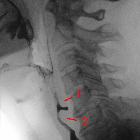Killian dehiscence


 nicht verwechseln mit: Killian-Jamieson space
nicht verwechseln mit: Killian-Jamieson spaceThe Killian dehiscence is a triangular-shaped area of weakness in the muscular wall of the pharynx, between the transverse and oblique bundles of the inferior pharyngeal constrictor . It is the most common site of pharyngeal diverticula .
Gross anatomy
It is located in the posterior wall of the laryngopharynx, slightly above the origin of the esophagus .
The Killian dehiscence is a triangular area of weakness formed by the oblique fibers of the inferior pharyngeal constrictor (thyropharyngeus), which attach anteriorly to the oblique lamina at the sides of the thyroid cartilage and posteriorly to the median raphe, and the transverse fibers of the inferior pharyngeal constrictor (cricopharyngeus), which attach to the sides of the cricoid cartilage anteriorly and wind around the pharynx, with no posterior attachment .
Internal to the inferior constrictor, the relatively strong pharyngobasilar fascia forms the submucosal lining. A relatively weaker buccopharyngeal fascia forms the external lining of the inferior constrictor .
Variant anatomy
While not anatomically evident in every individual, it has been found to occur more commonly in males . The dimensions of Killian's triangle of weakness have also been shown to correlate with individual anthropometric parameters, consequently being more prominent in males than in females .
One study suggests that it is present in ~60% of males, and just ~30% of females .This could explain why pharyngeal pouches are more common in males.
Development
Killian dehiscence arises due to the descent of the larynx during development . As the pharyngeal constrictors (apart from cricopharyngeus) are attached to the median raphe, which in turn is attached to the skull base, laryngeal descent during development causes the constrictors to assume an oblique course, leaving cricopharyngeus in a transverse orientation, thus creating a potential area of weakness .
History and etymology
It is named after Gustav Killian (1860-1921) a German otolaryngologist.
Related pathology
Uncoordinated contraction of the inferior pharyngeal constrictor and spasm, or fibrosis, of cricopharyngeus, have been implicated in the formation of pharyngeal pouches (Zenker diverticula), due to the increased intraluminal pressures these cause during swallowing. The increased intraluminal pressures then lead to herniation through this potential area of weakness .
Killian dehiscence is the most common site of pharyngeal diverticula .
Siehe auch:
und weiter:

 Assoziationen und Differentialdiagnosen zu Killian-Dreieck:
Assoziationen und Differentialdiagnosen zu Killian-Dreieck:


